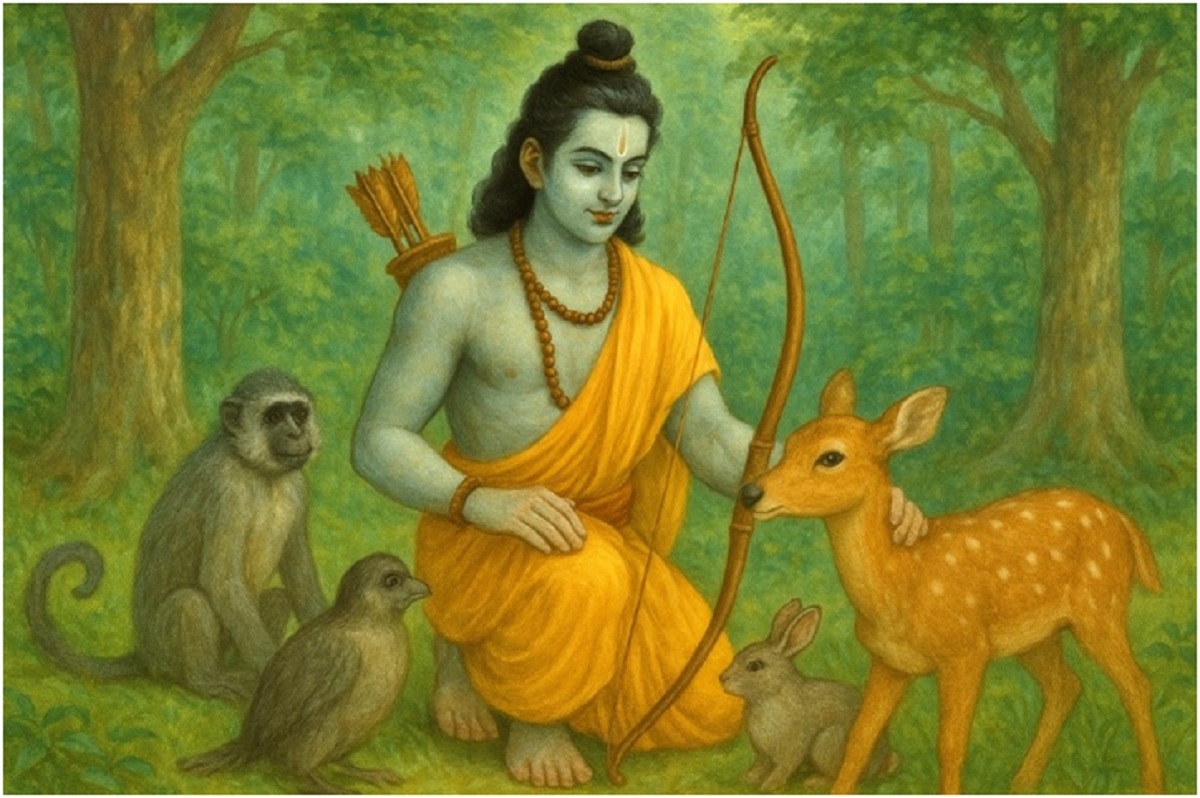Eco-Warrior Lord Ram Followed the Dharma of the Natural World

1. Ram in the Vanvaas
Ram’s exile is the turning point of the epic Ramayana. When Ram is banished to the forest, he is not stripped of power. Instead, he is initiated into a new kind of power... the strength that comes from living with nature. He traverses the Chitrakoot, Dandakaranya, Panchavati, and beyond (some of India’s most sacred green belts). In each of these locations, Ram chooses to dwell not in fortresses, but in humble cottages made of thatch, mud and bamboo. The materials are always locally sourced, always replenishable. There is no plunder nor concrete footprint.
In their life among forests, the three are not intruders, but temporary guests. The forest is not a resource to be converted into wealth. It is a character in the sacred story.
2. Jatayu and the Animal Kingdom
The story of Jatayu (the old vulture who gives up his life trying to rescue Sita) is often cited for its pathos. But its deeper message is ecological. When he finds the mortally wounded bird, Ram does not treat him as an inferior being. He does not dismiss the dying creature as mere fauna. Instead, he kneels and weeps. Here is a god-incarnate prince, performing for a bird the funeral rituals usually reserved for sages and humans. In this act, Ram affirms that the circle of dharma includes all beings. Animals are not “below” humans; they are part of the same spiritual continuum. His life had meaning. His death had dignity.
Throughout the Ramayana, Ram’s interactions with animals reinforce this worldview. He talks to monkeys as equals, respects their intelligence, seeks their counsel, and entrusts them with critical missions. Even Hanuman (a vanara) becomes not a servant but a soul-brother and a fellow warrior. In Ram’s world, nature is not dumb matter. It speaks and it fights alongside you when you honour it.
3. Student of Ecological Wisdom
Ram’s years in exile are also marked by frequent visits to forest hermitages, or ashrams, where sages live in austerity and communion with the elements. Ram does not dismiss them as impractical idealists. He seeks them out, asking for their blessings, absorbing their teachings, and defending them against the asuras who disrupt the natural order. In one such visit to Sage Atri and Anusuya, Sita learns about the principles of self-reliance, herbal medicine and mindful living. Anusuya tells her that true beauty is not in adornment but in one's relationship with prakriti (nature). These moments reveal the eco-philosophy at the core of the Ramayana, where human flourishing is impossible without ecological balance.
4. Building the Setubandhan Bridge
The chapter where Ram’s army builds a bridge to Lanka (Setubandhan) is frequently interpreted as a miraculous engineering feat. But it also demonstrates an environmental ethic.
Ram does not drill through the ocean. He asks permission from Samudradev, the sea god. When the ocean initially refuses, Ram shows restraint. He does not wage war on the water. He prays, fasts and seeks alignment with natural forces. This respectful negotiation with the sea speaks volumes. Ram understands that engineering must serve dharma, not disrupt it. His goal is not conquest, but connection.
5. Sanjeevani and the Sacredness of Plant Life
Perhaps the most iconic ecological moment in the Ramayana is when Hanuman is sent to fetch the Sanjeevani herb to save Lakshman’s life. Unable to identify it, he brings back an entire mountain. Here, the mountain is not plundered. It is borrowed.
Ram does not demand the mass harvesting of the Sanjeevani. He does not order armies of workers to extract and bottle it. He waits in silence as Hanuman flies across the sky, and when the herb revives Lakshman, it is seen not as human victory, but as nature’s grace. Trees and herbs in the Ramayana are sentient and potent. Even when Sita is abducted, she speaks to the trees and the river of her sorrow.
6. The Ethics of Restoration
When Ram returns to Ayodhya, after 14 years in the forest and a devastating war, he does not raze Lanka or install exploitative rule. Instead, he sets the kingdom right. He returns to a city but brings with him the values of the forest. His rule, Ram Rajya, is imagined as a time of abundance where animals and humans coexisted peacefully, and the rains arrived on time. These are not coincidental ecological symbols. They indicate a rebalanced cosmos, where human governance is in alignment with the environment.
Ram was not an ascetic renouncing the world. Nor was he a conqueror expanding empires. He was something rarer: a householder of the planet, a moral ruler who saw Earth not as property but as a parent.
In these times of climate anxiety and ecological collapse, perhaps what we need is not just green policies, but green myths. Not just data, but dharma. Ram’s story is not just India’s sacred epic. It is Earth’s memory of how humans can live gently, powerfully, and meaningfully... with the world, not against it.


